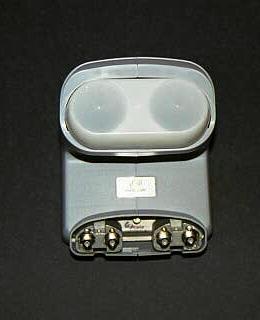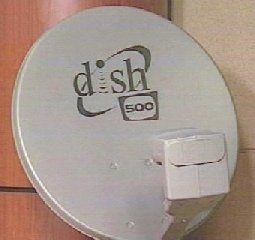
The Dish Network User's Resource

The Dish Network User's Resource
[Legacy][DishPro][DishPro Plus][Dual]
 |
 |
This is a photo of the Quad LNB. The Twin is in the same double-wide housing, but has only two outputs.
The two output Twin (embossed Dish logo on the back) and four output Quad (silver Dish logo sticker on the back) are intended to replace the pair of LNBFs that were originally used for a Dish 500. These LNBF/switch assemblies can be hooked directly from the Dish 500 to two and four receivers respectively, no external switches are required. The Twin was introduced in March 2000 bundled with the 4700 receiver. The Quad followed in June or July.
The Twin may be cascaded with SW21 switches to connect another dish for coverage of a third orbital slot. Nothing can be added to provide outputs for more than 2 tuners (or 1 dual-tuner receiver). If you need more outputs you need to consider your replacement options.
The last receivers which could not support the Twin/SW21 cascade were the 1000, 3000, 4000 (and their x500 clones) and the D-VHS. These were added after Dish supplied many LIL subscribers with SW64 switches or newer receivers to meet their “no additional expense to the customer” obligations under must carry rules. The 2000 never received the update before its demise in the spring of 2005.
01/15/00 Since this item was originally posted, Dish has started to update the software in many receivers to do 34 switch checks. It is rumored that this was done in anticipation of the imminent release of the “Twin” LNBF.
Systems with the Twin LNB are designated xx22T (legacy receivers) and xxx-22B (DishPro receivers).
04/21/00 Latest information from Dish indicate that the Twin and Quad LNB are not suitable for use in Alaska and Hawaii. Although the reason why isn't perfectly clear, it's most likely because the distance between the LNBs is only an approximation for the contiguous US. Outside that range, the approximation falls apart. Since the Dish 500 doesn't provide enough surface area for reception in Alaska and Hawaii, it seems like a moot point.
Dish is now selling Alaska and Hawaii HD service that comes from 110° spot beams. A separate dish is required for reception, so neither the Twin or Quad may be used.
The DishPro Twin has 2 LNBs with a built-in switch in a housing about 6" wide, appears identical to the Legacy Twin but has a prominent “dp” logo. Like the legacy model, it feeds 2 tuners or 1 dual-tuner model directly, and can be cascaded with 2 DP21 switches (legacy receivers require a DP Adapter). Unlike the legacy model, adding receivers does not require replacement because it can feed the DP34 or DPP44 for up to 12 receivers. Systems with the DP Twin are designated xxx-22D.
The DishPro Plus Twin adds a satellite input, the internal switch can be thought of as a “DPP32.” Can feed 2 dual-tuner models using 1 run of RG6 for each when used with a DishPro Separator. Recommended for systems with only 2 receivers, especially if either is a dual-tuner model, and not more than 1 legacy receiver. Available Jan 2005.
 Note that no version of the Twin may be referred to as a “dual.” Prior to the Twin and Quad, each orbital slot was received by a separate LNBF which had either 1 or 2 outputs and was called a single or a dual, respectively. If you had more than 2 receivers and/or more than 1 slot
you had to go through an external switch. Dish 500 had 2 singles (rare) or 2 duals. When the Legacy Twin was introduced, it integrated 2 dual LNBFs and an SW42
in a single housing. See What is Dish 500? for photos of the double dual and Twin configurations.
Note that no version of the Twin may be referred to as a “dual.” Prior to the Twin and Quad, each orbital slot was received by a separate LNBF which had either 1 or 2 outputs and was called a single or a dual, respectively. If you had more than 2 receivers and/or more than 1 slot
you had to go through an external switch. Dish 500 had 2 singles (rare) or 2 duals. When the Legacy Twin was introduced, it integrated 2 dual LNBFs and an SW42
in a single housing. See What is Dish 500? for photos of the double dual and Twin configurations.
Since the term “dual” was an established industry standard for a 1-satellite LNBF with 2 outputs, Dish came up with the name “Twin” for their new LNB/switch configuration. The incorrect identification is understandable though, since the names do not match the meanings. A twin (lower case, not Twin) is defined as one of 2 things that are alike, while dual refers to 1 thing with 2 parts. In the case of “Twin” vs “dual,” reality as established by Dish marketing says a Twin is 1 thing with 2 parts and a dual, especially as used on a Dish 500, becomes one of 2 things that are alike.
Thanks to ElecConnec for answering many of the early questions on the legacy Twin.
Page edited by BobaBird, submissions and corrections welcome.